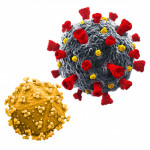What is COVID-19?
The SARS-CoV-2 coronavirus, which was first identified in China in late 2019, can cause a serious disease known as COVID-19. A majority of people who contract the virus will have mild to moderate illness and recover without treatment, but others develop severe disease. At first, COVID was thought to be primarily a respiratory illness, but it has become clear that the virus can cause complications throughout the body. Some people develop long-term symptoms known as long COVID.
How is the coronavirus transmitted?
SARS-CoV-2 mainly spreads through the air in respiratory droplets or aerosolized particles released when a person with the coronavirus coughs, sneezes, talks or breathes. People can transmit the virus even if they do not have symptoms. Some new SARS-CoV-2 variants spread more easily than the original strain.
SARS-CoV-2 transmission happens most often indoors, especially within households, in institutional settings such as nursing homes and prisons, and in crowded workplaces and social settings such as bars. Transmission is uncommon outdoors, though it can occur in crowded settings.
How can transmission be prevented?
Several precautions can reduce SARS-CoV-2 transmission. These are especially important for immunocompromised people, including cancer patients on active treatment, people with advanced or untreated HIV and organ transplant recipients.
- Wear a well-fitted mask or respirator (such as a N95 or KN95) indoors and in crowded outdoor settings.
- Wash your hands with soap and water frequently.
- Use hand sanitizer containing at least 60% alcohol.
- Stay home if you are sick.
Who is at risk for COVID-19?
While anyone can catch SARS-CoV-2, certain groups are at greater risk of developing severe illness:
- People ages 65 or older
- People with compromised immune systems
- People with preexisting health conditions.
While older people and those with other health conditions are more likely to develop severe disease, healthy young people—including children—can also become seriously ill.
Black and Latino communities have both higher infection rates and greater odds of severe illness and death.
Immunocompromised people are at greater risk for severe COVID. People with HIV who are on effective antiretroviral treatment and have a high CD4 cell count are not more likely to contract SARS-CoV-2 or develop severe illness, and most respond well to vaccines. However, those who are not on treatment, those with a detectable HIV viral load, those who have a low current CD4 count or had a very low count in the past are at greater risk.
What are the symptoms of COVID-19?
Most people with COVID have mild or moderate illness and will recover without special treatment. Some have few or no symptoms. But in some cases, COVID causes severe respiratory problems and can lead to hospitalization and death.
Early symptoms of COVID may include cough, shortness of breath, fever or chills, muscle or joint aches, sore throat, headache, gastrointestinal symptoms and loss of the sense of taste or smell. It takes around five days, on average, between exposure to the virus and the appearance of symptoms.
As the disease progresses, people may find it increasingly difficult to breathe. In the most severe cases, patients can develop acute respiratory distress syndrome, or widespread lung inflammation that requires oxygen therapy or mechanical ventilation. COVID can also affect other organs throughout the body, including the cardiovascular system and brain. Some people with SARS-CoV-2 develop prolonged symptoms, known as long COVID, that can last for months or years.
How is COVID-19 diagnosed?
SARSCoV-2 can be diagnosed using a PCR RNA test that detects viral genetic material in a nasal swab sample. Viral antigen tests, which can be done at home, detect fragments of viral proteins.
Another type of test detects SARS-CoV-2 antibodies in the blood, which show whether someone was infected in the past. However, not everyone who had COVID will have persistent antibodies.
Does COVID-19 lead to immunity?
After exposure, the immune system naturally produces antibodies against SARS-CoV-2. Vaccines mimic this response. People with compromised immunity—such as people receiving cancer treatment, people with advanced or untreated HIV and organ transplant recipients—may have a weaker immune response.
Antibody levels wane after a few months, and people who had COVID can get infected again. But memory B cells and T cells continue to provide protection against severe illness for a longer duration. Click here for more information about COVID immunity.
Who can get COVID-19 vaccines?
The first COVID-19 vaccines were authorized for emergency use in the United States in December 2020. Three vaccines are now authorized, from Pfizer-BioNTech, Moderna and Novavax. (A fourth vaccine, from Johnson & Johnson, is no longer available.)
The Pfizer-BioNTech and Moderna messenger RNA (mRNA) vaccines contain genetic blueprints for the SARS-CoV-2 spike protein. The Novavax vaccine delivers these proteins directly. The latest versions of the vaccines target newer viral variants. Health officials expect COVID vaccines will be updated annually.
The Centers for Disease Control and Prevention (CDC) recommends a single dose of the updated Pfizer-BioNTech or Moderna vaccine for everyone ages 6 years and older. People over 65 and immunocompromised individuals—including people receiving cancer treatment—may be eligible for a second dose. Children ages 6 months to 5 years may need multiple doses, depending on their prior vaccination history. The updated Novavax vaccine is authorized for people ages 12 and up. Click here for current CDC vaccine recommendations.
All of the authorized vaccines are generally safe and well tolerated. The most common side effect is temporary soreness, redness or swelling at the injection site. Some recipients experience flu-like symptoms, such as fever or fatigue. Severe allergic reactions (anaphylaxis) are rare. The Pfizer-BioNTech and Moderna vaccines rarely cause myocarditis, or heart inflammation, especially in young men.
Vaccines trigger the production of antibodies against SARS-CoV-2, but these typically wane after a few months. However, they also stimulate memory B-cell and T-cell responses, which provide longer-lasting protection. While the vaccines do not reliably prevent infection or mild illness, they are effective for preventing severe disease, hospitalization and death, and they may reduce the risk of developing long COVID. Immunocompromised people—including cancer patients on active treatment, people with advanced or untreated HIV and organ transplant recipients—may not respond as well to vaccines and may need additional doses.
COVID vaccines are safe and recommended for people living with HIV. While individuals with suppressed immunity may not respond as well, the vaccines still offer some protection.
Click here for more information about COVID-19 vaccines.
How is COVID-19 treated?
People with mild to moderate COVID can usually manage their symptoms with supportive care at home, similar to care for the flu. This includes taking over-the-counter medications for fever, cough and pain, drinking plenty of fluids and getting adequate rest.
In more severe cases, people with COVID may require hospitalization for advanced care. This may involve breathing supplemental oxygen or, if patients can’t breathe on their own, the use of a ventilator machine.
There are three approved antiviral medications for COVID: nirmatrelvir/ritonavir (Paxlovid), remdesivir (Veklury) and molnupiravir (Lagevrio). Paxlovid is indicated for the treatment of mild to moderate COVID in adults who are at risk for progression to severe disease. To be effective, treatment must be started within a few days after symptoms first appear.
Monoclonal antibodies were previously used to treat COVID and prevent progression to severe illness, but the virus developed resistance, and they are no longer effective. Researchers are working to develop new antibodies for COVID prevention and treatment. Some immunocompromised people may benefit from convalescent plasma, which contains natural antibodies from people who have recovered from COVID.
The Infectious Diseases Society of America offers Guidelines on the Treatment and Management of Patients with COVID-19, which are updated to reflect new research.
What about long COVID?
Some people with SARS-CoV-2 develop prolonged symptoms that can last for months or years. About 10% of people develop a chronic condition known as long COVID. Studies have shown that vaccination and treatment with Paxlovid or metformin may lower the risk of long COVID.
People with long COVID have reported more than 200 symptoms, including severe fatigue, brain fog (cognitive impairment), postural orthostatic tachycardia syndrome (changes in heart rate and blood pressure when standing up) and post-exertional malaise (inability to recover from physical or mental exertion). In some cases, the condition can be disabling.
The biology of long COVID is not well understood. Leading hypotheses include persistent SARS-CoV-2 infection, reactivation of existing latent viruses (such as Epstein-Barr virus), abnormal immune responses that persist after acute infection and autoimmunity.
People with long COVID have tried a wide variety of treatments. While some patients report improvement, and some therapies have shown some benefit in small studies, there are currently no approved treatments, and this is an active area of clinical research.
For more information about COVID-19, visit our sister site COVID Health.
Last Reviewed: October 3, 2023














